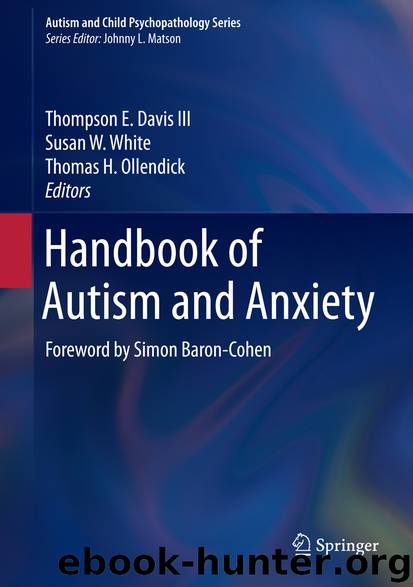Handbook of Autism and Anxiety by Thompson E. Davis III Susan W. White & Thomas H. Ollendick

Author:Thompson E. Davis III, Susan W. White & Thomas H. Ollendick
Language: eng
Format: epub
Publisher: Springer International Publishing, Cham
DSM-5: Implications and Thoughts on Changes to ASD and SAD Diagnoses
There is more scientific recognition and clinical appreciation for the possibility of co-occurrence of social anxiety in a person with diagnosed ASD. A PsycINFO search (July 16, 2013) using the keywords of “autism” and “social anxiety” yields only 27 peer-reviewed articles; half of these articles, however, were published in just the past 3 years. This zeitgeist is also reflected in changes to the DSM-5 . In the text description for SAD, ASD is now listed as one of the common comorbid conditions and it is stated that anxiety is common in those with ASD diagnoses. The changes seen in DSM-5, notably that the criterion of recognition of the irrationality of one’s social fears has been removed and that it is made explicit that people with ASD can and often do have social anxiety, will likely result in increased identification of social anxiety in people with ASD, and dual diagnosis of SAD and ASD .
As such, the importance of determining how to most sensitively assess for social anxiety in individuals (children as well as adults) with ASD cannot be overstated. There is considerable risk of “double-counting” symptoms (e.g., social avoidance, poor eye contact, few friends) to derive diagnoses of both SAD and ASD. To clarify the construct of social anxiety as it manifests in people with ASD, novel assessment approaches as well as clinical criteria should be explored. Measures of psychophysiological reactivity (e.g., heart rate and heart rate variability) or attention (e.g., reaction time tasks and eye gaze tracking), for instance, might augment more traditional indices of social anxiety such as interviews and questionnaires. Understanding the individual’s ability to hypothesize about others’ thoughts and feelings (theory of mind) and his or her social motivation or need for connectedness may also be useful clinically. We also need to consider intraindividual developmental factors and societal changes in evaluating social anxiety in ASD. In adolescence, for example, there is a heightened focus on social relationships and the feedback of peers. The DSM-5 emphasizes that ASD can indeed be diagnosed later in life, rather than only in early childhood, and the usual age of onset of SAD is mid-adolescence. When assessing and treating adolescent clients presenting with social concerns, it is especially important to consider the history of social concerns (i.e., were deficits present prior to adolescence?) and the presence (or absence) of restricted, repetitive patterns of behavior or interests, as deficits in social communication and interaction alone are not sufficient for the ASD diagnosis. Finally, in the USA, like most other developed countries, we are simultaneously more connected to each other (via instant messaging, texting, and other forms of social media) and yet more disconnected than we have ever been. Young people meet each other and socialize electronically, perhaps more so than in person. The possible societal and clinical ramifications of these changes have yet to be empirically examined. Anecdotally, however, we have seen countless clinical examples of adolescents and young adults with extensive virtual relationships but nonexistent human socialization.
Download
This site does not store any files on its server. We only index and link to content provided by other sites. Please contact the content providers to delete copyright contents if any and email us, we'll remove relevant links or contents immediately.
Periodization Training for Sports by Tudor Bompa(8167)
Why We Sleep: Unlocking the Power of Sleep and Dreams by Matthew Walker(6618)
Paper Towns by Green John(5086)
The Immortal Life of Henrietta Lacks by Rebecca Skloot(4523)
The Sports Rules Book by Human Kinetics(4288)
Dynamic Alignment Through Imagery by Eric Franklin(4115)
ACSM's Complete Guide to Fitness & Health by ACSM(3987)
Kaplan MCAT Organic Chemistry Review: Created for MCAT 2015 (Kaplan Test Prep) by Kaplan(3938)
Introduction to Kinesiology by Shirl J. Hoffman(3720)
Livewired by David Eagleman(3680)
The Death of the Heart by Elizabeth Bowen(3550)
The River of Consciousness by Oliver Sacks(3533)
Alchemy and Alchemists by C. J. S. Thompson(3447)
Bad Pharma by Ben Goldacre(3350)
Descartes' Error by Antonio Damasio(3229)
The Emperor of All Maladies: A Biography of Cancer by Siddhartha Mukherjee(3061)
The Gene: An Intimate History by Siddhartha Mukherjee(3046)
The Fate of Rome: Climate, Disease, and the End of an Empire (The Princeton History of the Ancient World) by Kyle Harper(3003)
Kaplan MCAT Behavioral Sciences Review: Created for MCAT 2015 (Kaplan Test Prep) by Kaplan(2935)
